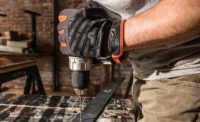One size doesn’t fit all: women’s PPE needs

Over the past 20 years, the face of America’s construction workforce has changed. From 1985 to 2007, the number of women employed in the U.S. construction industry grew by 81.3 percent. Even though less than 10 percent of all U.S. construction workers are women, by 2011 there were already more than 800,000 women employed in various sectors of the construction industry (U.S. Bureau of Labor Statistics).
As the number of women in construction continues to rise, so should concern for their health and safety. While both male and female construction workers face many of the same dangers on the job, including fatal falls, electrocutions and entrapment, other unique challenges greatly impact women, heightening their risk of work-related injury, illness and death.
Occupational hazards specific to female construction workers are real; failure to acknowledge them undermines the safety of even the most well-organized, well-equipped workplaces. Providing adequate safety and health protection for an increasingly diverse construction workforce is vital and doable. Follow these four simple steps to ensure you properly address critical safety and fall protection concerns for women in construction.
1. Purchase the right protective equipment.
During the past decade, personal protective equipment (PPE) manufacturers have adapted to meet the needs of women. Availability of safety equipment designed, styled and sized for use by women has grown dramatically.
As you evaluate available PPE options, try to purchase equipment that not only meets OSHA regulations and ANSI standards, but also comes in size ranges suitable for women. Today’s full-body harnesses are customized products designed with specialty features that keep workers comfortable, productive and safe on the job. The smartest approach entails maintaining a directory of manufacturers and suppliers, identifying a wide selection of size ranges, keeping appropriate sizes on hand and ensuring direct accessibility. Keep in mind that when equipment doesn’t fit, the protection it’s designed to offer is greatly reduced.
2. Facilitate hands-on equipment tests.
Many women in nontraditional jobs, especially the construction trades, have encountered improperly fitting PPE, which compromises their safety on the job. Equipment used by your workers should be based on body measurement data. Make a point to have all women try the PPE you provide in a controlled training environment, especially full-body harnesses, to determine if it’s uncomfortable or not suitable for wear because of improper fit, deterioration, damage or defect.
Physiological differences between women and men can translate into occupational hazards. It’s crucial to have workers demonstrate adequate knowledge relating to the harness features as well as the tools attached to the harness in order to make the right adjustments for a good, easy-to-don fit. Workers of all shapes and sizes should have well-fitting, reliable fall protection equipment to ensure safe and efficient performance day after day.
3. Maintain comprehensive training and continued support.
To this day, many women may think their male coworkers are more proficient due to the ongoing mentoring, coaching and training they receive from other male colleagues, amidst ongoing pressure to get the job done faster. A work environment that fosters productivity before safety, and a lack of support for site-wide training, sets the stage for dangerous, even potentially fatal, consequences.
Though many employers think implementing PPE solves all safety issues, the leading causes of injury from falls remain the improper utilization of the fall protection systems and improper equipment issued. In the past few years, the industry has developed an impressive array of cost-effective devices to significantly reduce the hazards to employees exposed to a fall. Unfortunately, many employers may be still unaware they’re using the wrong equipment, or may be providing inadequate training to employees on how to apply this technology to their workplace.
Without proper training, workers are more likely to become injured, or be seen as incompetent. It’s your responsibility to get the facts and provide a well rounded, mandatory training program that teaches employees how to recognize fall hazards and how to minimize them.
4. Foster a culture of safety and fairness for all.
Harassment and verbal abuse on construction jobsites is not uncommon. Many workers wrongly believe they have to put up with occasional harassment to keep their jobs and build rapport with their fellow crew members.
Working in a hostile workplace can cause workers to become distracted and overlook proper safety precautions, potentially leading to serious injury or death from accidents on the job, including falls. Cultivating a productive, safe work environment and breaking down discriminatory barriers starts with you. Actively discourage discrimination and harassment, and implement and enforce strict policies against both.
As the construction workforce continues to diversify, it’s imperative for you to revisit and revise traditional practices in order to provide safe and healthy work conditions for all — regardless of race, gender or background. Ensure all workers are equipped with fall protection that meets their individual needs, and helps them do their job better and safer.
Looking for a reprint of this article?
From high-res PDFs to custom plaques, order your copy today!





